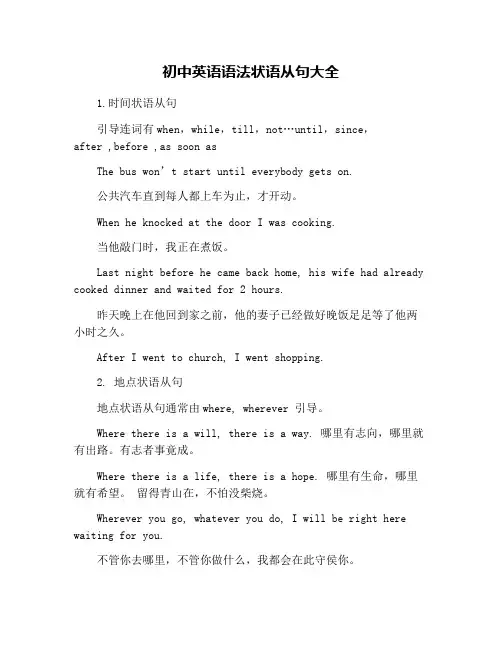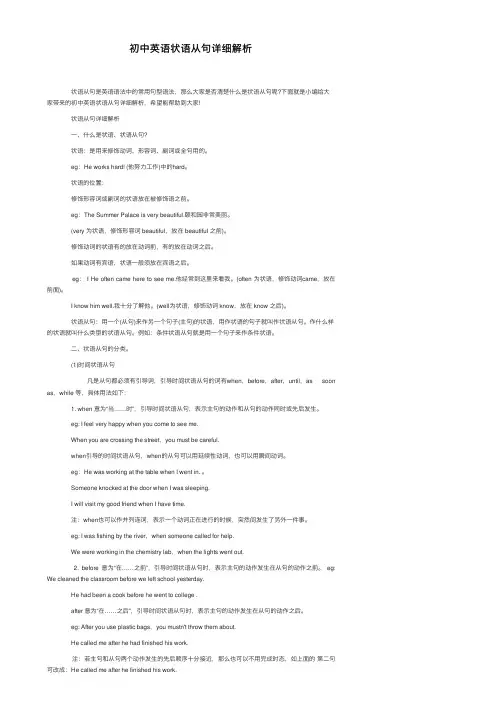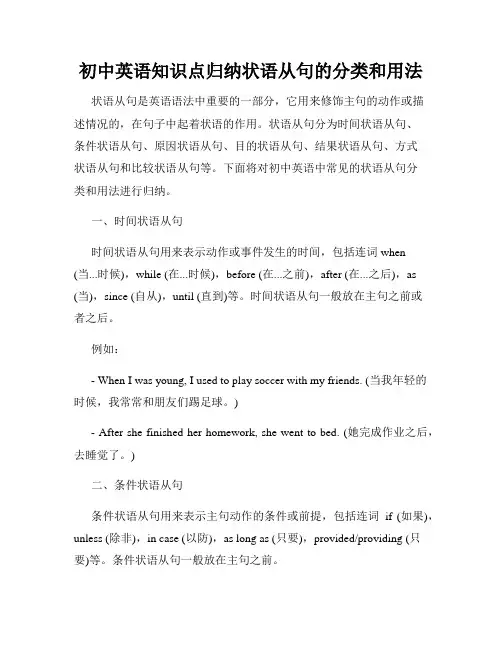初中英语语法大全——状语从句
初中英语语法状语从句大全

初中英语语法状语从句大全1.时间状语从句引导连词有when,while,till,not…until,since,after ,before ,as soon asThe bus won’t start until everybody gets on.公共汽车直到每人都上车为止,才开动。
When he knocked at the door I was cooking.当他敲门时,我正在煮饭。
Last night before he came back home, his wife had already cooked dinner and waited for 2 hours.昨天晚上在他回到家之前,他的妻子已经做好晚饭足足等了他两小时之久。
After I went to church, I went shopping.2. 地点状语从句地点状语从句通常由where, wherever 引导。
Where there is a will, there is a way. 哪里有志向,哪里就有出路。
有志者事竟成。
Where there is a life, there is a hope. 哪里有生命,哪里就有希望。
留得青山在,不怕没柴烧。
Wherever you go, whatever you do, I will be right here waiting for you.不管你去哪里,不管你做什么,我都会在此守侯你。
3.原因状语从句引导连词有because,as, since。
He didn′t see the film because he had seen it.他没有看那部电影,因为他已经看过了。
They couldn’t get on the train,for it was too crowed.比较:because, since, as和for1) because语势,用来说明人所不知的原因,回答why提出的问题。
初中英语状语从句详细解析

初中英语状语从句详细解析 状语从句是英语语法中的常⽤句型语法,那么⼤家是否清楚什么是状语从句呢?下⾯就是⼩编给⼤家带来的初中英语状语从句详细解析,希望能帮助到⼤家! 状语从句详细解析 ⼀、什么是状语、状语从句? 状语:是⽤来修饰动词、形容词、副词或全句⽤的。
eg:He works hard! (他努⼒⼯作)中的hard。
状语的位置: 修饰形容词或副词的状语放在被修饰语之前。
eg:The Summer Palace is very beautiful.颐和园⾮常美丽。
(very 为状语,修饰形容词 beautiful,放在 beautiful 之前)。
修饰动词的状语有的放在动词前,有的放在动词之后。
如果动词有宾语,状语⼀般须放在宾语之后。
eg: I He often came here to see me.他经常到这⾥来看我。
(often 为状语,修饰动词came,放在前⾯)。
I know him well.我⼗分了解他。
(well为状语,修饰动词 know,放在 know 之后)。
状语从句:⽤⼀个(从句)来作另⼀个句⼦(主句)的状语,⽤作状语的句⼦就叫作状语从句。
作什么样的状语就叫什么类型的状语从句。
例如:条件状语从句就是⽤⼀个句⼦来作条件状语。
⼆、状语从句的分类。
(1)时间状语从句 凡是从句都必须有引导词,引导时间状语从句的词有when,before,after,until,as soon as,while 等,具体⽤法如下: 1. when 意为“当……时”,引导时间状语从句,表⽰主句的动作和从句的动作同时或先后发⽣。
eg: I feel very happy when you come to see me. When you are crossing the street,you must be careful. when引导的时间状语从句,when的从句可以⽤延续性动词,也可以⽤瞬间动词。
初中英语语法状语从句课件(共45张PPT)

• 3)than 意为“比……更……”; • The boy is taller_than_his_father. (比他的父
亲还高)
4)比较状语从句通常与倍数表达法结合起来运用。
①A +is…times +as+ adj.原级+as +B ②A +is…times+ adj.比较级+than +B ③A +is…times+ the size/length/height/width/depth +of + B ④The size/length/height/width/depth… +of+ A+ is…times of +B
where引导 A句+where+B句 在B句…地方, A句… 在环境污染严重的地方,许多珍稀物种处于灭 绝的边缘。
Many rare animals are on the verge of extinction where environmental pollution is serious.
三、条件状语从句 1. If引导的条件句 2. Unless 3. Once 4. As long as
• 这个数据在下降到1990年的20%之前,它先上 升到1980年的80%
• Before the figure jumped to 20% in 1990, it increased to 80% in 1980.
• 5. A句+since+B句/时间短语 【自从B句…,A句就…】
自从手机发明以来,人们的生活发生了巨大变化。
五、目的状语从句
A句+in order that+B句 A句+so that+B句 【A句…是为了B句…】
初中英语语法状语从句(共16张PPT)

1)though, although, as, while
A. though和although不能与but连用
B. as引导让步状语从句,意思与 although/though相同,但是as通常放 在句首,且主谓要倒装,as前面的词可 以是形容词、副词,也可以是动词、名 词。
1)Rich as he is, he is not happy.
You should try to get a good night’ sleep ________ much work you have to do.
Hale Waihona Puke A. howeverB. no matter
C. although D. whatever
解析:答案为A。本题考察让步状语从句的 用法
______I accept that he is not perfect, I do actually like the person.
= Although he is a child, he knows what to do at this time.
C. while引导让步状语从句,只能放在句首, 意思与although/though相同。
While I feel sympathetic, I really can’t do anything to help them. While he may be right, we don’t agree him to do it.
where you have any questions.
3. 原因(because, as, since, now that, seeing that, considering that; when = since, considering that 既然;考 虑到; 介词短语表原因– because of, thanks to, due to, owing to; for )
初中英语语法之状语从句类型及考点讲义

初中英语语法之状语从句类型及考点讲义状语从句概念解析状语从句指句子用作状语时,起副词作用的句子,可以修饰谓语、非谓语动词、定语、状语或整个句子,可分为时间、地点、原因、条件、目的、结果、让步、方式和比较等从句,是英语复合句学习的一个重点,在各类考试中都会经常出现,这次就来给大家讲解一下什么是状语从句。
1. 时间状语从句:常用引导词:when, as, while, as soon as, before, after, since , till, until特殊引导词:the minute, the moment, the second, every time, the day,the instant, immediately , directly, no sooner … than, hardly …when, scarcely … when instantlyI ran into the classroom as soon as the bell rang.2. 地点状语从句:常用引导词:where特殊引导词:wherever, anywhere, everywhereWherever the sea is , you will find seamen.3. 原因状语从句:常用引导词:because=in that, since=now that, as, for特殊引导词:seeing that, now that, in that, considering that, given thatI 'm late because I didn't caught the bus.4. 目的状语从句:常用引导词:so that, in order that特殊引导词: for fear that(唯恐/生怕),in the hope that, for the purpose that, to the end thatYou should book the hotel in advance so that the travel will be more easy.5.结果状语从句:常用引导词:so … that, such … that特殊引导词:such that, to the degree that, to the extent that, to such a degree thatHe is so young that he can't have meal by himself.6. 条件状语从句:常用引导词:if, unless,特殊引导词:as/so long as(只要), only if, providing/provided that(倘若), supposing that(倘若), in case that(以防), on condition thatYou can go to London as long as you have passport.7.让步状语从句:常用引导词:though, although, even if, even though特殊引导词: as(用在让步状语从句中必须要倒装),while,no matter …, in spite of the fact that, whatever, whoever, wherever, whenever, however, whichever, as if=as thoughThough we are old, we still can do these by ourselves.8. 比较状语从句:常用引导词:as(同级比较), than(不同程度的比较)特殊引导词:the more …the more …; just as …,so…,no … more than; not A so much as BShe is as pretty as her mother.9. 方式状语从句:常用引导词:as, as if, how特殊引导词:the wayHe didn't so it the way his brother did.辨析:while,when,as三者引导的时间状语从句时间状语从句算是状语从句中最简单的一类,也是我们日常生活交流中最常用的一类,虽然难度不大,但引导词也不少,仍然有不少同学会弄混那几个常见引导词的用法,这次就为大家带来as,when,while这几个词的辨析方法,一起看看吧。
初中英语知识点归纳状语从句的分类和用法

初中英语知识点归纳状语从句的分类和用法状语从句是英语语法中重要的一部分,它用来修饰主句的动作或描述情况的,在句子中起着状语的作用。
状语从句分为时间状语从句、条件状语从句、原因状语从句、目的状语从句、结果状语从句、方式状语从句和比较状语从句等。
下面将对初中英语中常见的状语从句分类和用法进行归纳。
一、时间状语从句时间状语从句用来表示动作或事件发生的时间,包括连词when (当...时候),while (在...时候),before (在...之前),after (在...之后),as (当),since (自从),until (直到)等。
时间状语从句一般放在主句之前或者之后。
例如:- When I was young, I used to play soccer with my friends. (当我年轻的时候,我常常和朋友们踢足球。
)- After she finished her homework, she went to bed. (她完成作业之后,去睡觉了。
)二、条件状语从句条件状语从句用来表示主句动作的条件或前提,包括连词if (如果),unless (除非),in case (以防),as long as (只要),provided/providing (只要)等。
条件状语从句一般放在主句之前。
例如:- If it rains tomorrow, we will stay at home. (如果明天下雨,我们就在家呆着。
)- Unless you work hard, you won't pass the exam. (除非你努力学习,否则你就不能通过考试。
)三、原因状语从句原因状语从句用来表示主句动作或情况的原因,包括连词because (因为),as (因为),since (因为),for (因为),now that (既然)等。
原因状语从句一般放在主句之前。
例如:- Because it was raining, we stayed at home. (因为下雨,我们呆在家里。
初中英语语法公式状语从句
初中英语语法公式状语从句在初中英语中,状语从句是一种非常常见的句子结构,用来修饰句子的谓语动词,增加句子的信息和意义。
以下是几种常见的初中英语语法公式状语从句:1. 时间状语从句(Time Adverbial Clause):- when(当...时候):I will go to the park when I finish my homework.- while(当...时候):He reads a book while he is waiting for the bus.- before(在...之前):Please finish your dinner before you watch TV.- after(在...之后):I usually clean my room after I have breakfast.2. 地点状语从句(Place Adverbial Clause):- where(在...的地方):She can sit wherever she likes.- wherever(无论在哪里):You can find him wherever he goes.3. 原因状语从句(Reason Adverbial Clause):- because(因为):He stayed at home because it was raining outside.- since(因为):She didn't go to the party since she was not feeling well.4. 条件状语从句(Conditional Adverbial Clause):- if(如果):If it rains tomorrow, we will stay at home.- unless(除非):You can't go outside unless you finish your homework.5. 方式状语从句(Manner Adverbial Clause):- as(如同):She ran as fast as she could.- like(像):He dances like a professional.这些状语从句的使用可以丰富句子的表达,使句子更加清晰明了。
初中英语状语从句知识点总结
初中英语状语从句知识点总结状语从句是英语语法中的一个重要部分,它用来修饰或限定主句中的动作或状态。
以下是初中英语状语从句的知识点总结:1. 时间状语从句(Time clauses):用来表示动作发生的时间,常用的连词有when, while, before, after, until, as soon as等。
2. 地点状语从句(Place clauses):用来表示动作发生的地点,常用的连词有where, wherever等。
例如:I will go wherever you go.(无论你去哪儿我都会跟随。
)3. 原因状语从句(Cause clauses):用来表示动作发生的原因,常用的连词有because, since, as等。
4. 结果状语从句(Result clauses):用来表示动作的结果,常用的连词有so, such...that等。
例如:The movie was so interesting that I couldn't stop watching.(这部电影太有趣了,我看得停不下来。
)5. 条件状语从句(Condition clauses):用来表示动作发生的条件,常用的连词有if, unless, provided that等。
例如:If it rains, we will stay at home.(如果下雨,我们会呆在家里。
6. 目的状语从句(Purpose clauses):用来表示动作的目的,常用的连词有in order that, so that等。
例如:I bought a new notebook so that I can take notes in class.(我买了一个新笔记本,这样我可以在课堂上记笔记。
)7. 方式状语从句(Manner clauses):用来表示动作发生的方式,常用的连词有as, as if, as though等。
例如:He speaks as if he knows everything.(他说话的样子就像他什么都知道。
2024年人教版中考英语语法课件:状语从句知识点归纳
Wherever my sister visits, she will send me a postcard. =No matter where my sister visits, she will send me a postcard.
as
当.....时, 一边...一边...
强调主从句动作同时进行
I saw the sun as I opened the window.
1、时间状语从句
2、until/ till 引导词: ① until和till意为“直到”,很多时候可以互换,但是用于句首的时候,常用until。 Until you get back, I will sit here.
3、让步状语从句
(表示主句中的某一动作或状态与从句中的某一动作或状态在意义上有部分矛盾。) 1、although/though 引导词: although/though意为“尽管,虽然”,不与but连用,但可用yet/ still. Although/ though he works hard, yet he makes slow porgress.
③ She is such a beautiful girl that everybody loves her.
4、结果状语从句
(结果状语从句表示主句中某一动ห้องสมุดไป่ตู้或状态所产生的结果)
4、so…that… 与 such… that… 互换: 两者都意为“如此......以致于”
so+形容词+a/an+单数可数名词+that从句 人称代=s词uc是h为+a了/a避n+免我形重们容复、词,他+用们单来/数代她可替们数前/名面它词提们到”+等t过h代a的t词从人。句、人事称物代等词名有词人的称词、,单主复要数包以括及“你格、的我变、化他。,她/它、你们、
初中英语语法大全之状语从句专项讲解
2、地点状语从句
常用引导词:where 例句 Generally, air will be heavily polluted where there are factories.
3、原因状语从句
常用引导词:because, since, as, for 例句 My friends dislike me because I'm handsome and successful.
To such an degree was he excited that he couldn't sleep last night.
6、条件状语从句
常用引导词: if, unless 例句 We‘ll start our project if the president agrees.
7、让步状语从句
when
既可以表示在某一点的时候,又可表示在某一段时间内。
when可以和延续性动词连用,也可以和短暂性动词连用;而 while 和 as只能和延续性动词连用 ;
when从句的谓语动词可以在主句谓语动作之前、之后或同时 发生;while和as从句的谓语动作必须是和主句谓语动作同时
发生。
When we were at school, we went to the library every day. (在一段时间内)
,when,while,as都可使用。 主句中的动作或事情是在从句中的动作或事情的进展过程中
发生,从句中的动词一般要用延续性动词。
When /While /As we were dancing,a stranger came in. (dance为延续性动词)
Please don’t talk so loud while others are working.
- 1、下载文档前请自行甄别文档内容的完整性,平台不提供额外的编辑、内容补充、找答案等附加服务。
- 2、"仅部分预览"的文档,不可在线预览部分如存在完整性等问题,可反馈申请退款(可完整预览的文档不适用该条件!)。
- 3、如文档侵犯您的权益,请联系客服反馈,我们会尽快为您处理(人工客服工作时间:9:00-18:30)。
初中英语语法大全——状语从句在句中起状语作用的从句叫作状语从句。
状语从句可以位于句前、向中成向居。
位于句首时,常用迅号与主句隔开,位于句中时以句前后须用过号,位于句居时,从句的前面可以不用逗号。
状语从句主要包括时间状语从句地点状语从句、条件状语从句、原因状语从句、目的状语从句、结果状语从句、让步状语从句方式状语从句和比较状语从句。
一、时间状语从句引导时间状语从句的从属连词主要有when( ..时候),while( ...时候),as( ...时候), before(在...之前),after(在....之后),until/till(直到......),... since( ...以来),as soon as(一.......就......)等。
在时间状语从句中,要注意时态一致。
1.when, while和as的用法(1) when, while和as的共同用法when, while和as都可以引导时间状语从句,意为“当......时候”。
若表示主何中的动词和从句中的动作同时发生,而从句的谓语动词是延续性动词时,这三个词是等同的,可以互换。
eg: When/While/As we were dancing, a stranger came in. 当我们跳舞的时候,一个陌生人进来了。
eg: When/While/As I was taking a bath, the telephone rang. 我在洗澡的时候,电话响了。
(2) when, while和as的用法区别①when引导的时间状语从句的谓语动词既可以是延续性的,也可以是非延续性的,而while引导的时间状语从句的谓语动词只能是延续性的。
eg: When you came in, I was talking with a few boys. 你进来时,我正在和几个男孩子谈话。
eg: While we were waiting for the bus, it was raining heavily. 我们等公交车时,天正下着大雨。
②while和as常表示从句的动作与主句的动作同时发生,而when表示从句的动作发生在主句的动作之前、之后,也可同时发生。
eg: They rushed in while/as we were discussing problems. 当我们正在讨论问题时,他们冲了进来。
eg: When he had finished his homework, he took a short rest. 他写完作业后,休息了一会儿。
eg: When I got to the airport, the guests had left. 当我到达机场时,客人们已经离开了。
③while表示两个延续性动作同时发生而又有对比意义,主从句的时态通常是相同的。
eg: While she was making a phone call, I was writing a letter. 她打电话时,我正在写信。
eg: Eddie was sleeping while Millie was reading a magazine. 艾迪在睡觉而米莉在看杂志。
④as意为“随..... .... 边....”常用于表示两个动作同时或者几乎同时发生;表示两个发展变化中的情况;表示在某事发生的过程中另外一一件事发生;表示随着短暂动作的发生,另一动作立刻发生。
eg: As you older, you will know better and better about yourself. 随着年龄的增长,你会越来越了解自己。
eg: As he was reading , he was shaking his head. 他边读书边摇头。
2. as soon as的用法as soon as意为“一....就 ...”,表示从句的动作一发生,主句的动作随即发生。
eg: Mom, I'm leaving for Beijing tomorrow. --- That's nice. You'd better ring me up as soon as you get there. 妈妈,明天我将去北京。
--- 那很好。
你最好一到那里就给我打个电话。
eg: As soon as he heard the news, he jumped with joy. 一听到这个消息,他高兴地跳了起来。
2.since的用法(1) since意为“自从....”, 主句常用现在完成时或般现在时,从句常用一般过去时。
eg: I have lived in England since I was three. 自3岁起我就一直住在英国。
eg: It is two years since I became a college student. 我成为一名大学生已经两年了。
(2) 从句谓语不同,表达的意义不同。
① since引导的从句的谓语如果是延续性动词成者表示状态的动词,则从句表示的时间是从该动作或状态结束时算起。
eg: It has been a year since he worked here. 他不在这里工作已经一年了。
eg: He has written to me regularly since he was ill.自从病好以来,他定期给我来信。
② since引导的从句的谓语如果是延续性动词,则从句表示的时间是从该动作开始的那刻算起。
eg: We haven't seen each other since we parted. 自从分手以后我们一直没有见过面。
eg: We have been good friends since we joined the team. 自从加入这个队以来,我们就成了好朋友。
③ It is/has been..since句式“It is/has been+时间段since从句”句式表示“自...以来有(多久)”。
since从句不可以用否定句。
eg: It is has been 5 years since we last met. 自从我们上次见面以来已经有5年了。
eg: It has been a long time sine Mary was ill. 玛丽病好很长时间了。
④ until /till的用法until/till意为“直到....为止”。
当主句为否定句时,常构成“not...until...”结构,意为“直到......才......”(1) 主句是否定句时主句如果是否定句,谓语动词需用非延续性动词,表示主句的云作到从句表示的时间点才开始。
eg: You can't leave until you have finished your homework. 家庭作业写完后你才能离开。
eg: I didn't know anything about it until you told me. 直到你告诉我,我才知道关于这件事情的一切。
(2)主句是肯定句时主句如果是肯定句,谓语动词需用延续性动词,表示主句的动作直到从句表示的时间点就结束。
eg: I will wait for you until/till you come back. 我会一直等,直到你回来。
eg: You may stay here until/till the rain stops. 你可以在这里一直待到雨停。
(3)用于句首时,常用until而不用tilleg: Until you told me, I had heard nothing of what happened.直到你告诉我以前,我一点都不知道出了什么事。
eg: Until the manager returns, nothing can be done. 经理不回来,什么也不能做。
5. before, after的用法before意为“.....之前”时,表示主句动作发生在从句动作之前。
after意为“.....之后”,表示主句动作发生在从句动作之后。
eg: Please turn off the lights before you leave the classroom. 请在离开教室前关上灯。
eg: He arrived after the game started. 比赛开始后他才到。
6. by the time 的用法by the time常用来指到某时间点为止,主句常用完成时态。
eg: By the time he was 12, he had travelled to more than 30 countries.到12岁为止,他已经去过30多个国家了。
eg: By the time I got outside, the bus had already left. 我到外面时,公交车已经开走了。
7. 名词短语引导时间状语从句的用法表示时间的名词短语有时也可以引导时间状语从句,常见的此类时间短语有the time the moment the minute the day the last time the second timeeach day every time next time any timeeg: The day he returned home, his father was already dead. 他到家的那天,他父亲已经去世了。
eg: He said he' d phone you the moment he got home. 他说他一到家就给你打电话。
eg: He was much better the last time I saw him. 上次我见到他时,他好多了。
eg: Every time I see him, he is working hard. 我每次见到他,他都在拼命地工作。
二、地点状语从句在句子中充当地点状语的从句称为地点状语从句。
引导地点状语从句的从属连词主要有where( ...地方), wherever(无论问处)等,表示地点方位。
eg: I found all the missing things where I left them. 我在丢东西的地方找到了所有丢了的东西。
eg: Where there is a will, there is a way. 有志者,事竟成。
eg: You are free to go wherever you like. 你可以随意到你喜欢的任何地方去。
eg: Wherever there is smoke, there is fire. 无火不生烟。
